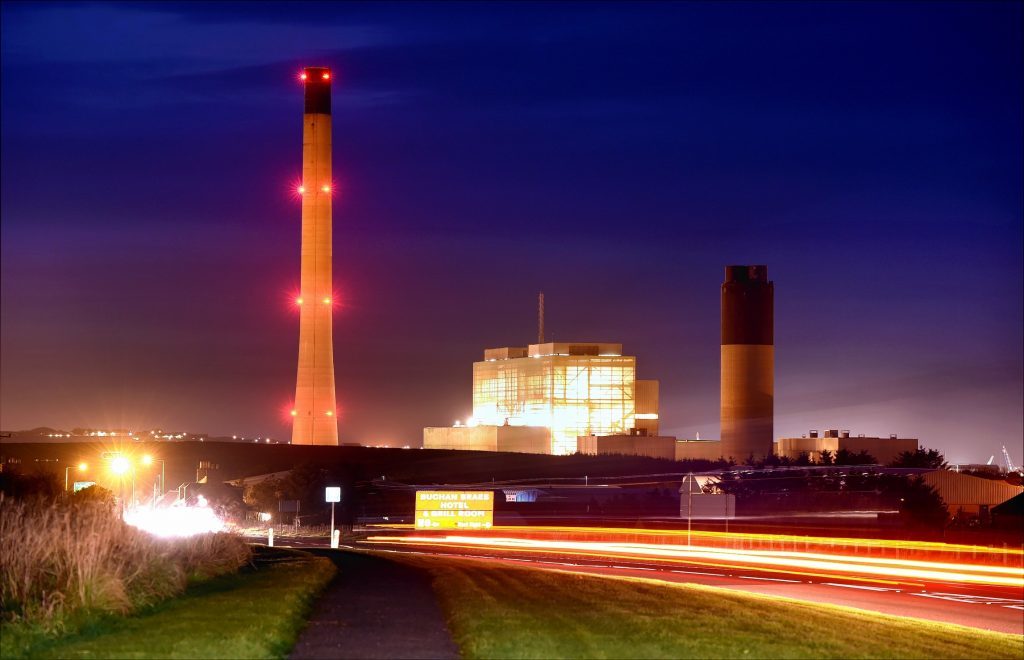
Much attention in recent years has been devoted to cleaning up traditional fossil fuel power plants with carbon capture and storage (CCS).
Due to the ease of retrofitting existing power stations, most of the emphasis has been on post-combustion capture.
This involves removing carbon dioxide from the power station flue gases before eventually compressing it into a liquid. In the UK, depleted offshore oil and gas fields have been proposed as potential storage facilities for the liquefied carbon dioxide.
So far, UK CCS is still not much further forward after more than 10 years of endeavour. Why? In his contribution to a Beis-commissioned report on CCS, Lord Oxburgh said: “There is no serious commercial incentive and it will stay that way unless the state demonstrates there is a business there.”
It doesn’t help that the technology has several major difficulties. The process of removing, treating and pumping carbon dioxide is costly and energy intensive. For a gas fired power station utilising a post combustion CCS scheme, capture results in an additional parasitic load of 11-22%. That means the power station has to burn typically 16% more gas to provide the capture power. That means a 16% increase in emissions.
As with any CCS scheme, there are significant pipeline costs and concerns about the security of the carbon store.
Furthermore, if the power station requires 16% more gas, then the gas supplier has to process and transport 16% more gas, resulting in additional, indirect harmful air emissions. With air quality of particular concern in the UK, the implementation of CCS looks like a bad idea.
Although the technology has been around for many years, NETPOWER’s Oxy-combustion using the Allam cycle has received much acclaim. Indeed it has been touted to be the ‘holy grail’ of CCS. The process involves separating oxygen from air, burning oxygen with the hydrocarbon fuel and using the combustion products – water and carbon dioxide – to drive a high-pressure turbine. To improve thermal efficiency, hot carbon dioxide is pressurised and recycled back to the burners. Carbon dioxide is also produced at a pressure suitable for pipeline transportation. Whilst it looks to be a very promising technology the fact remains that it still burns fossil fuels and produces carbon dioxide – a holy grail?
Furthermore, this method is not suitable for power station retrofit, so it will do nothing to address carbon dioxide emissions from the UK’s existing fossil fuel, power generation fleet.
Recently the post combustion CCS scheme at the Peterhead Gas Fired Power Station was cancelled. Shell and SSE planned to deliver the world’s first full scale CCS project in Scotland. They claimed that up to 10million tonnes of carbon dioxide emissions could be captured over a 10-year period from a gas turbine. Eighty-five percent of the carbon dioxide from the gas turbine would be captured. The carbon dioxide was to be transported by pipeline and stored 60 miles offshore in the depleted Goldeneye gas reservoir.
Let’s put the Peterhead carbon dioxide saving in context. Cooking accounts for 16% of the UK’s annual domestic electricity use. In other words, 17.3 terawatt hours (Twh) out of a total of 108Twh is used for cooking.
Cooking can be further sub-divided as follows: Power usage for our kettles is 34% of 17.3Twh, or 5.9Twh per annum. In terms of a power station output that would be the equivalent of 670megawatts (MW).
Domestic kettle use is particularly inefficient as we regularly overfill our kettles. We boil much more water than we need. We could readily save at least half of that energy if we boiled only the water required to make our tea and coffee. We’d save about 335MW. Peterhead CCS was saving 85% of the output from a 400MW gas turbine – 340MW. So we could remove about the same amount of carbon dioxide as the proposed Peterhead CCS by not overfilling our kettles.
In addition, and unlike post-combustion CCS, kettle management can be implemented immediately. It costs nothing. There would be a corresponding reduction in other atmospheric pollutants and, of course, we would save on our electricity bills. So, what’s it to be: Peterhead CCS or kettle smart?
Of course being kettle smart will deliver only a fraction of the UK’s required carbon reduction goals.
But it does illustrate why energy efficiency is a much smarter way of reducing carbon dioxide and other harmful air emissions than CCS.
So what else could be done? Smart lighting, switching off computers and monitors, and not leaving TVs on standby are just some of the numerous ideas available to the domestic consumer. If we could achieve the aim of the carbon neutral house, we could shut down half of the UK’s existing gas-fired power stations.
If industry and other non-domestic consumers made energy savings to the tune of 20%, there would be a corresponding saving in gas power stations. Is 20% realistic? As a chemical engineer with 40 years’ industry experience, I am confident that number is achievable. Key areas to be considered would be pump and compressor efficiency, energy use in separation processes, combined heat and power, furnace fuel management, green concrete and energy integration.
Accelerating renewables energy provision to displace fossil fuel based generation would also be key to delivering the UK’s carbon goals.
Furthermore, CCS need not be confined to power station applications. Bio Energy with CCS (BECCS) seems a much more promising technology than burning fossil fuels.
So let’s scrap fossil fuel combustion CCS, be energy smart and prevent the carbon dioxide and other harmful emissions being produced in the first place.
Tom Baxter is a senior lecturer of chemical engineering at Aberdeen University
Recommended for you
